Meteorological Conditions Associated with Lightning Ignited Fires and Long-Continuing-Current Lightning in Arizona, New Mexico and Florida
Abstract
:1. Introduction
2. Data and Methodology
2.1. Lightning Data
2.2. Forest Fire Databases
2.3. Vegetation Type Database
2.4. Meteorological Data and Satellite Measurements
2.5. Search of Lightning-Candidates for the Fires
2.6. Analysis of Meteorological Conditions
- Resample the data with replacement of the same size as the original by taking random samples.
- Compute the bootstrap distribution of the statistic.
- Determine the confidence interval.
- Compare the 95% CIs of the medians of the meteorological parameters of LIW with the 95% CIs of the meteorological medians of typical CG to look for overlaps between CIs.
- Resample the data with a replacement of the same size as the original by taking random samples.
- Compute the bootstrap distribution of the statistic.
- Determine the confidence interval.
- Compare the 95% CIs of the medians of the meteorological parameters of LIW with the 95% CIs of the meteorological medians of typical CG to look for overlaps between CIs.
3. Results
3.1. Lightning Candidates for Fires
3.2. Meteorological Conditions of LIW
3.2.1. Arizona and New Mexico
3.2.2. Florida
3.3. Identification of LCC (>18 ms) Lightning
3.4. Shared Meteorological Conditions of Thunderstorms Producing LIW and LCC Lightning
4. Discussion
4.1. Preferential Meteorological Conditions for LIW Occurrence in Arizona and New Mexico and Florida
4.2. Relationship between LIW and LCC (>18 ms) Lightning Occurrence
5. Summary and Conclusions
- The lightning-ignition efficiency in coniferous forests such as ponderosa pine in Arizona and New Mexico and slash pine in Florida is higher than in other forest types of these regions.
- High temperature between the ground and the 800 hPa level, low precipitation rates, and high-based clouds favor the occurrence of LIW in Arizona and New Mexico and in Florida.
- The meteorological conditions that favor the occurrence of LIW in Arizona and New Mexico are closely related with the meteorological conditions that favor high lightning activity (strong updraft, high ice content in clouds) and are compatible with low precipitation supercells. In FL, the preferential meteorological conditions for LIW are similar, although more shifted towards the conditions that favor the ignition and spread of fire (low precipitation rate, high surface temperature, high-based clouds).
- In Arizona and New Mexico and in FL, LCC (>18 ms) lightning tends to occur during thunderstorms that have higher values for relative humidity than the lightning climatology and lower values for temperature in the entire troposphere. In addition, the ice content of clouds tends to be lower and the updraft weaker in the lower troposphere for thunderstorms producing LCC (>18 ms) lightning.
- The meteorological conditions associated with the occurrence of LCC (>18 ms) lightning in Arizona and New Mexico and in Florida are not necessarily the same meteorological conditions that favor the occurrence of LIW.
Supplementary Materials
Author Contributions
Funding
Institutional Review Board Statement
Informed Consent Statement
Data Availability Statement
Acknowledgments
Conflicts of Interest
Abbreviations
| ABI | Advanced Baseline Imager |
| AGCP | Atlantic and Gulf Coastal Plain |
| ANM | Arizona and New Mexico |
| CBH | Cloud Base Height |
| CG | Cloud-to-Ground |
| CTH | Cloud Top Height |
| COMMAS | Collaborative Model for Multiscale Atmospheric Simulation |
| CONUS | Continental United States |
| ERA5 | European Centre for Medium-Range Weather Forecasts (ECMWF) fifth-generation reanalysis |
| FL | Florida |
| GLM | Geostationary Lightning Mapper |
| GOES-16 | Geostationary Operational Environmental Satellite-16 |
| HAMMA | Huntsville Alabama Marx Meter Array |
| IC | Intra-cloud |
| ISS | International Space Station |
| LCC | Long-Continuing-Current |
| LIE | Lightning Ignition Efficiency |
| LIS | Lightning Imaging Sensor |
| LIW | Lightning-Ignited Wildfires |
| LLS | Lightning Location Systems |
| NICC | National Interagency Coordination Center |
| NLDN | National Lightning Detection Network |
| OTD | Optical Transient Detector |
| TT | Total Totals Index |
| VLF | Very Low Frequency |
| WMAW | Western Mountains and the Arid West |
References
- Balch, J.K.; Bradley, B.A.; Abatzoglou, J.T.; Nagy, R.C.; Fusco, E.J.; Mahood, A.L. Human-started wildfires expand the fire niche across the United States. Proc. Natl. Acad. Sci. USA 2017, 114, 2946–2951. [Google Scholar] [CrossRef] [Green Version]
- Coniglio, M.C.; Stensrud, D.J.; Wicker, L.J. Effects of upper-level shear on the structure and maintenance of strong quasi-linear mesoscale convective systems. J. Atmos. Sci. 2006, 63, 1231–1252. [Google Scholar] [CrossRef] [Green Version]
- Lyons, W.A.; Nelson, T.E.; Williams, E.R.; Cramer, J.A.; Turner, T.R. Enhanced Positive Cloud-to-Ground Lightning in Thunderstorms Ingesting Smoke from Fires. Science 1998, 282, 77. [Google Scholar] [CrossRef] [PubMed]
- Anderson, K. A model to predict lightning-caused fire occurrences. Int. J. Wildland Fire 2002, 11, 163–172. [Google Scholar] [CrossRef]
- Stocks, B.; Mason, J.; Todd, J.; Bosch, E.; Wotton, B.; Amiro, B.; Flannigan, M.; Hirsch, K.; Logan, K.; Martell, D.; et al. Large forest fires in Canada, 1959–1997. J. Geophys. Res. Atmos. 2002, 107, FFR–5. [Google Scholar] [CrossRef]
- Wotton, B.; Martell, D.L. A lightning fire occurrence model for Ontario. Can. J. For. Res. 2005, 35, 1389–1401. [Google Scholar] [CrossRef]
- Hall, B.L.; Brown, T.J. Climatology of positive polarity flashes and multiplicity and their relation to natural wildfire ignitions. In Proceedings of the International Lightning Detection Conference, Tucson, AZ, USA, 24–25 April 2006; pp. 24–25. [Google Scholar]
- Fernandes, W.A.; Pinto, I.R.; Pinto, O., Jr.; Longo, K.M.; Freitas, S.R. New findings about the influence of smoke from fires on the cloud-to-ground lightning characteristics in the Amazon region. Geophys. Res. Lett. 2006, 33, L20810. [Google Scholar] [CrossRef] [Green Version]
- Kochtubajda, B.; Flannigan, M.; Gyakum, J.; Stewart, R.; Logan, K.; Nguyen, T.V. Lightning and fires in the Northwest Territories and responses to future climate change. Arctic 2006, 59, 211–221. [Google Scholar] [CrossRef] [Green Version]
- Lang, T.J.; Rutledge, S.A. Cloud-to-ground lightning downwind of the 2002 Hayman forest fire in Colorado. Geophys. Res. Lett. 2006, 33, L07801. [Google Scholar] [CrossRef] [Green Version]
- Rosenfeld, D.; Fromm, M.; Trentmann, J.; Luderer, G.; Andreae, M.; Servranckx, R. The Chisholm firestorm: Observed microstructure, precipitation and lightning activity of a pyro-cumulonimbus. Atmos. Chem. Phys. 2007, 7, 645–659. [Google Scholar] [CrossRef] [Green Version]
- Hall, B.L. Precipitation associated with lightning-ignited wildfires in Arizona and New Mexico. Int. J. Wildland Fire 2007, 16, 242–254. [Google Scholar] [CrossRef]
- Altaratz, O.; Koren, I.; Yair, Y.; Price, C. Lightning response to smoke from Amazonian fires. Geophys. Res. Lett. 2010, 37, L03804. [Google Scholar] [CrossRef] [Green Version]
- Dowdy, A.J.; Mills, G.A. Atmospheric and fuel moisture characteristics associated with lightning-attributed fires. J. Appl. Meteorol. Climatol. 2012, 51, 2025–2037. [Google Scholar] [CrossRef]
- Nauslar, N.J.; Kaplan, M.L.; Wallmann, J.; Brown, T.J. A Forecast Procedure for Dry Thunderstorms. J. Oper. Meteorol. 2013, 1. [Google Scholar] [CrossRef]
- Lang, T.J.; Rutledge, S.A.; Dolan, B.; Krehbiel, P.; Rison, W.; Lindsey, D.T. Lightning in wildfire smoke plumes observed in Colorado during summer 2012. Mon. Weather Rev. 2014, 142, 489–507. [Google Scholar] [CrossRef] [Green Version]
- Veraverbeke, S.; Rogers, B.M.; Goulden, M.L.; Jandt, R.R.; Miller, C.E.; Wiggins, E.B.; Randerson, J.T. Lightning as a major driver of recent large fire years in North American boreal forests. Nat. Clim. Chang. 2017, 7, 529. [Google Scholar] [CrossRef]
- McEachron, K.; Hagenguth, J. Effect of lightning on thin metal surfaces. IEEE Trans. Commun. 1942, 61, 559–564. [Google Scholar]
- Fuquay, D.M.; Baughman, R.; Taylor, A.; Hawe, R. Characteristics of seven lightning discharges that caused forest fires. J. Geophys. Res. 1967, 72, 6371–6373. [Google Scholar] [CrossRef]
- Pérez-Invernón, F.J.; Huntrieser, H.; Soler, S.; Gordillo-Vázquez, F.J.; Pineda, N.; Navarro-González, J.; Reglero, V.; Montanyà, J.; van der Velde, O.; Koutsias, N. Lightning-ignited wildfires and long-continuing-current lightning in the Mediterranean Basin: Preferential meteorological conditions. Atmos. Chem. Phys. Discuss. 2021, 21, 17529–17557. [Google Scholar] [CrossRef]
- Pérez-Invernón, F.J.; Huntrieser, H.; Jöckel, P.; Gordillo-Vázquez, F.J. A parameterization of long-continuing-current (LCC) lightning in the lightning submodel LNOX (version 3.0) of the Modular Earth Submodel System (MESSy, version 2.54). Geosci. Model Dev. 2022, 15, 1545–1565. [Google Scholar] [CrossRef]
- Rorig, M.L.; McKay, S.J.; Ferguson, S.A.; Werth, P. Model-generated predictions of dry thunderstorm potential. J. Appl. Meteorol. Climatol. 2007, 46, 605–614. [Google Scholar] [CrossRef] [Green Version]
- Pineda, N.; Rigo, T. The rainfall factor in lightning-ignited wildfires in Catalonia. Agric. Forest Meteorol. 2017, 239, 249–263. [Google Scholar] [CrossRef]
- Vant-Hull, B.; Thompson, T.; Koshak, W. Optimizing precipitation thresholds for best correlation between dry lightning and wildfires. J. Geophys. Res. Atmos. 2018, 123, 2628–2639. [Google Scholar] [CrossRef]
- MacNamara, B.R.; Schultz, C.J.; Fuelberg, H.E. Flash characteristics and precipitation metrics of Western US lightning-initiated wildfires from 2017. Fire 2020, 3, 5. [Google Scholar] [CrossRef] [Green Version]
- Krawchuk, M.; Cumming, S.; Flannigan, M.D.; Wein, R. Biotic and abiotic regulation of lightning fire initiation in the mixedwood boreal forest. Ecology 2006, 87, 458–468. [Google Scholar] [CrossRef]
- Reineking, B.; Weibel, P.; Conedera, M.; Bugmann, H. Environmental determinants of lightning-v. human-induced forest fire ignitions differ in a temperate mountain region of Switzerland. Int. J. Wildland Fire 2010, 19, 541–557. [Google Scholar] [CrossRef]
- Müller, M.M.; Vacik, H.; Diendorfer, G.; Arpaci, A.; Formayer, H.; Gossow, H. Analysis of lightning-induced forest fires in Austria. Theor. Appl. Climatol. 2013, 111, 183–193. [Google Scholar] [CrossRef] [Green Version]
- Moris, J.V.; Conedera, M.; Nisi, L.; Bernardi, M.; Cesti, G.; Pezzatti, G.B. Lightning-caused fires in the Alps: Identifying the igniting strokes. Agric. For Meteorol. 2020, 290, 107990. [Google Scholar] [CrossRef]
- Pineda, N.; Altube, P.; Alcasena, F.J.; Casellas, E.; San Segundo, H.; Montanyà, J. Characterizing the holdover phase of lightning-ignited wildfires in Catalonia. SSRN 2022. [Google Scholar] [CrossRef]
- Flannigan, M.; Wotton, B. Lightning-ignited forest fires in northwestern Ontario. Can. J. For. Res. 1991, 21, 277–287. [Google Scholar] [CrossRef]
- Ogilvie, C. Lightning Fires in Saskatchewan Forests; Fire Management Notes-US Department of Agriculture, Forest Service (USA): Singapore, 1989.
- Wallmann, J. A procedure for forecasting dry thunderstorms in the Great Basin using the dynamic tropopause and alternate tools for assessing instability. NOAA/NWS WR Tech. Attach 2004, 4–8. [Google Scholar]
- Hersbach, H.; Bell, B.; Berrisford, P.; Hirahara, S.; Horányi, A.; Muñoz-Sabater, J.; Nicolas, J.; Peubey, C.; Radu, R.; Schepers, D.; et al. The ERA5 global reanalysis. Q. J. R. Meteorol. Soc. 2020, 146, 1999–2049. [Google Scholar] [CrossRef]
- Thépaut, J.N.; Dee, D.; Engelen, R.; Pinty, B. The Copernicus programme and its climate change service. In Proceedings of the IGARSS 2018 IEEE International Geoscience and Remote Sensing Symposium, Valencia, Spain, 22–27 July 2018; pp. 1591–1593. [Google Scholar]
- Marsh, D.R.; Mills, M.J.; Kinnison, D.E.; Lamarque, J.F.; Calvo, N.; Polvani, L.M. Climate change from 1850 to 2005 simulated in CESM1 (WACCM). J. Clim. 2013, 26, 7372–7391. [Google Scholar] [CrossRef] [Green Version]
- Jöckel, P.; Tost, H.; Pozzer, A.; Kunze, M.; Kirner, O.; Brenninkmeijer, C.A.; Brinkop, S.; Cai, D.S.; Dyroff, C.; Eckstein, J.; et al. Earth system chemistry integrated modelling (ESCiMo) with the modular Earth submodel system (MESSy) version 2.51. Geosci. Model. Dev. 2016, 9, 1153–1200. [Google Scholar] [CrossRef] [Green Version]
- Mitchener, L.J.; Parker, A.J. Climate, lightning, and wildfire in the national forests of the southeastern United States: 1989–1998. Phys. Geogr. 2005, 26, 147–162. [Google Scholar] [CrossRef]
- Slocum, M.G.; Platt, W.J.; Beckage, B.; Panko, B.; Lushine, J.B. Decoupling natural and anthropogenic fire regimes: A case study in Everglades National Park, Florida. Nat. Areas J. 2007, 27, 41–55. [Google Scholar] [CrossRef]
- Duncan, B.W.; Adrian, F.W.; Stolen, E.D. Isolating the lightning ignition regime from a contemporary background fire regime in east-central Florida, USA. Can. J. For. Res. 2010, 40, 286–297. [Google Scholar] [CrossRef]
- Nag, A.; Murphy, M.J.; Schulz, W.; Cummins, K.L. Lightning locating systems: Insights on characteristics and validation techniques. Earth Space Sci. 2015, 2, 65–93. [Google Scholar] [CrossRef]
- Medici, G.; Cummins, K.L.; Cecil, D.J.; Koshak, W.J.; Rudlosky, S.D. The intracloud lightning fraction in the contiguous United States. Mon. Weather Rev. 2017, 145, 4481–4499. [Google Scholar] [CrossRef] [Green Version]
- Cummins, K.L.; Murphy, M.J. An overview of lightning locating systems: History, techniques, and data uses, with an in-depth look at the US NLDN. IEEE Trans. Electromagn. Compat. 2009, 51, 499–518. [Google Scholar] [CrossRef]
- Zhu, Y.; Lyu, W.; Cramer, J.; Rakov, V.; Bitzer, P.; Ding, Z. Analysis of location errors of the US National Lightning Detection Network using lightning strikes to towers. J. Geophys. Res. Atm. 2020, 125, e2020JD032530. [Google Scholar]
- Rudlosky, S.D.; Shea, D.T. Evaluating WWLLN performance relative to TRMM/LIS. Geophys. Res. Lett. 2013, 40, 2344–2348. [Google Scholar] [CrossRef]
- Christian, H.J.; Blakeslee, R.J.; Boccippio, D.J.; Boeck, W.L.; Buechler, D.E.; Driscoll, K.T.; Goodman, S.J.; Hall, J.M.; Koshak, J.M.; Mach, D.M.; et al. Global frequency and distribution of lightning as observed from space by the Optical Transient Detector. J. Geophys. Res. 2003, 108, ACL 4-1–ACL 4-15. [Google Scholar] [CrossRef]
- Boccippio, D.J.; Koshak, W.J.; Blakeslee, R.J. Performance assessment of the optical transient detector and lightning imaging sensor. Part I: Predicted diurnal variability. J. Atmos. Ocean Technol. 2002, 19, 1318–1332. [Google Scholar] [CrossRef]
- Mach, D.M.; Christian, H.J.; Blakeslee, R.J.; Boccippio, D.J.; Goodman, S.J.; Boeck, W.L. Performance assessment of the Optical Transient Detector and Lightning Imaging Sensor. J. Geophys. Res. Atm. 2007, 112. [Google Scholar] [CrossRef]
- Cecil, D.J.; Buechler, D.E.; Blakeslee, R.J. Gridded lightning climatology from TRMM-LIS and OTD: Dataset description. Atmos. Res. 2014, 135, 404–414. [Google Scholar] [CrossRef] [Green Version]
- Bitzer, P.M.; Christian, H.J. Timing uncertainty of the Lightning Imaging Sensor. J. Atmos. Ocean Technol. 2015, 32, 453–460. [Google Scholar] [CrossRef]
- Bitzer, P.M. Global distribution and properties of continuing current in lightning. J. Geophys. Res. Atm. 2017, 122, 1033–1041. [Google Scholar] [CrossRef]
- Wright, D.K.; Glasgow, L.S.; McCaughey, W.W.; Sutherland, E.K. Coram Experimental Forest 15 Minute Streamflow Data; U.S. Department of Agriculture, Forest Service, Rocky Mountain Research Station: Fort Collins, CO, USA, 2011. [CrossRef]
- Short, K.C. Spatial Wildfire Occurrence Data for the United States, 1992–2018 [FPA_FOD_20210617], 5th ed.; Forest Service Research Data Archive: Fort Collins, CO, USA, 2021.
- Ruefenacht, B.; Finco, M.; Nelson, M.; Czaplewski, R.; Helmer, E.; Blackard, J.; Holden, G.; Lister, A.; Salajanu, D.; Weyermann, D.; et al. Conterminous US and Alaska forest type mapping using forest inventory and analysis data. Photogramm. Eng. Remote Sens. 2008, 74, 1379–1388. [Google Scholar] [CrossRef]
- Podur, J.; Martell, D.L.; Csillag, F. Spatial patterns of lightning-caused forest fires in Ontario, 1976–1998. Ecol. Modell. 2003, 164, 1–20. [Google Scholar] [CrossRef]
- Poli, P.; Hersbach, H.; Dee, D.P.; Berrisford, P.; Simmons, A.J.; Vitart, F.; Laloyaux, P.; Tan, D.G.; Peubey, C.; Thépaut, J.N.; et al. ERA-20C: An atmospheric reanalysis of the twentieth century. J. Clim. 2016, 29, 4083–4097. [Google Scholar] [CrossRef]
- Larjavaara, M.; Pennanen, J.; Tuomi, T. Lightning that ignites forest fires in Finland. Agric. Forest Meteorol. 2005, 132, 171–180. [Google Scholar] [CrossRef]
- Schultz, C.J.; Nauslar, N.J.; Wachter, J.B.; Hain, C.R.; Bell, J.R. Spatial, Temporal and Electrical Characteristics of Lightning in Reported Lightning-Initiated Wildfire Events. Fire 2019, 2, 18. [Google Scholar] [CrossRef] [PubMed] [Green Version]
- Kruskal, W.H.; Wallis, W.A. Use of ranks in one-criterion variance analysis. J. Am. Stat. Assoc. 1952, 47, 583–621. [Google Scholar] [CrossRef]
- Efron, B.; Tibshirani, R.J. An Introduction to the Bootstrap; CRC Press: Boca Raton, FL, USA, 1994. [Google Scholar]
- Barth, M.C.; Cantrell, C.A.; Brune, W.H.; Rutledge, S.A.; Crawford, J.H.; Huntrieser, H.; Carey, L.D.; MacGorman, D.; Weisman, M.; Pickering, K.E.; et al. The deep convective clouds and chemistry (DC3) field campaign. Bull. Am. Meteorol. Soc. 2015, 96, 1281–1309. [Google Scholar] [CrossRef] [Green Version]
- Soler, A.; Pineda, N.; San Segundo, H.; Bech, J.; Montanyà, J. Characterisation of thunderstorms that caused lightning-ignited wildfires. Int. J. Wildland Fire 2021, 30, 954–970. [Google Scholar] [CrossRef]
- Pineda, N.; Montanyà, J.; Van der Velde, O.A. Characteristics of lightning related to wildfire ignitions in Catalonia. Atmos. Res. 2014, 135, 380–387. [Google Scholar] [CrossRef]
- Finney, D.; Doherty, R.; Wild, O.; Huntrieser, H.; Pumphrey, H.; Blyth, A. Using cloud ice flux to parametrise large-scale lightning. Atmos. Chem. Phys. 2014, 14, 12665–12682. [Google Scholar] [CrossRef] [Green Version]
- Grant, L.D.; Van Den Heever, S.C. Microphysical and dynamical characteristics of low-precipitation and classic supercells. J. Atmos. Sci. 2014, 71, 2604–2624. [Google Scholar] [CrossRef]
- Conedera, M.; Cesti, G.; Pezzatti, G.; Zumbrunnen, T.; Spinedi, F. Lightning-induced fires in the Alpine region: An increasing problem. For. Ecol. Manag. 2006, 234, S68. [Google Scholar] [CrossRef]
- Markowski, P.; Hannon, C.; Frame, J.; Lancaster, E.; Pietrycha, A.; Edwards, R.; Thompson, R.L. Characteristics of vertical wind profiles near supercells obtained from the Rapid Update Cycle. Weather Forecast. 2003, 18, 1262–1272. [Google Scholar] [CrossRef]
- Fuquay, D.M. A model for predicting lightning fire ignition in wildland fuels. In Intermountain Forest and Range Experiment Station, Forest Service, US; Facsimile Publisher: New Delhi, India, 1979; Volume 217. [Google Scholar]
- Krause, A.; Kloster, S.; Wilkenskjeld, S.; Paeth, H. The sensitivity of global wildfires to simulated past, present, and future lightning frequency. J. Geophys. Res. Biogeosci. 2014, 119, 312–322. [Google Scholar] [CrossRef] [Green Version]
- Coughlan, R.; Di Giuseppe, F.; Vitolo, C.; Barnard, C.; Lopez, P.; Drusch, M. Using machine learning to predict fire-ignition occurrences from lightning forecasts. Meteorol. Appl. 2021, 28, e1973. [Google Scholar] [CrossRef]
- Goodman, S.J.; Blakeslee, R.J.; Koshak, J.M.; Mach, D.; Bailey, J.; Buechler, D.; Carey, L.; Schultz, C.; Bateman, M.; McCaul, E.; et al. The GOES-R geostationary lightning mapper (GLM). Atmos. Res. 2013, 125, 34–49. [Google Scholar] [CrossRef] [Green Version]
- Rudlosky, S.D.; Goodman, S.J.; Virts, K.S.; Bruning, E.C. Initial geostationary lightning mapper observations. Geophys. Res. Lett. 2019, 46, 1097–1104. [Google Scholar] [CrossRef]
- Fairman, S.I.; Bitzer, P.M. The Detection of Continuing Current in Lightning Using the Geostationary Lightning Mapper. J. Geophys. Res. Atmos. 2022, 127, e2020JD033451. [Google Scholar] [CrossRef]
- Schmidt, C. Monitoring fires with the GOES-R series. In The GOES-R Series; Elsevier: Amsterdam, The Netherlands, 2020; pp. 145–163. [Google Scholar]
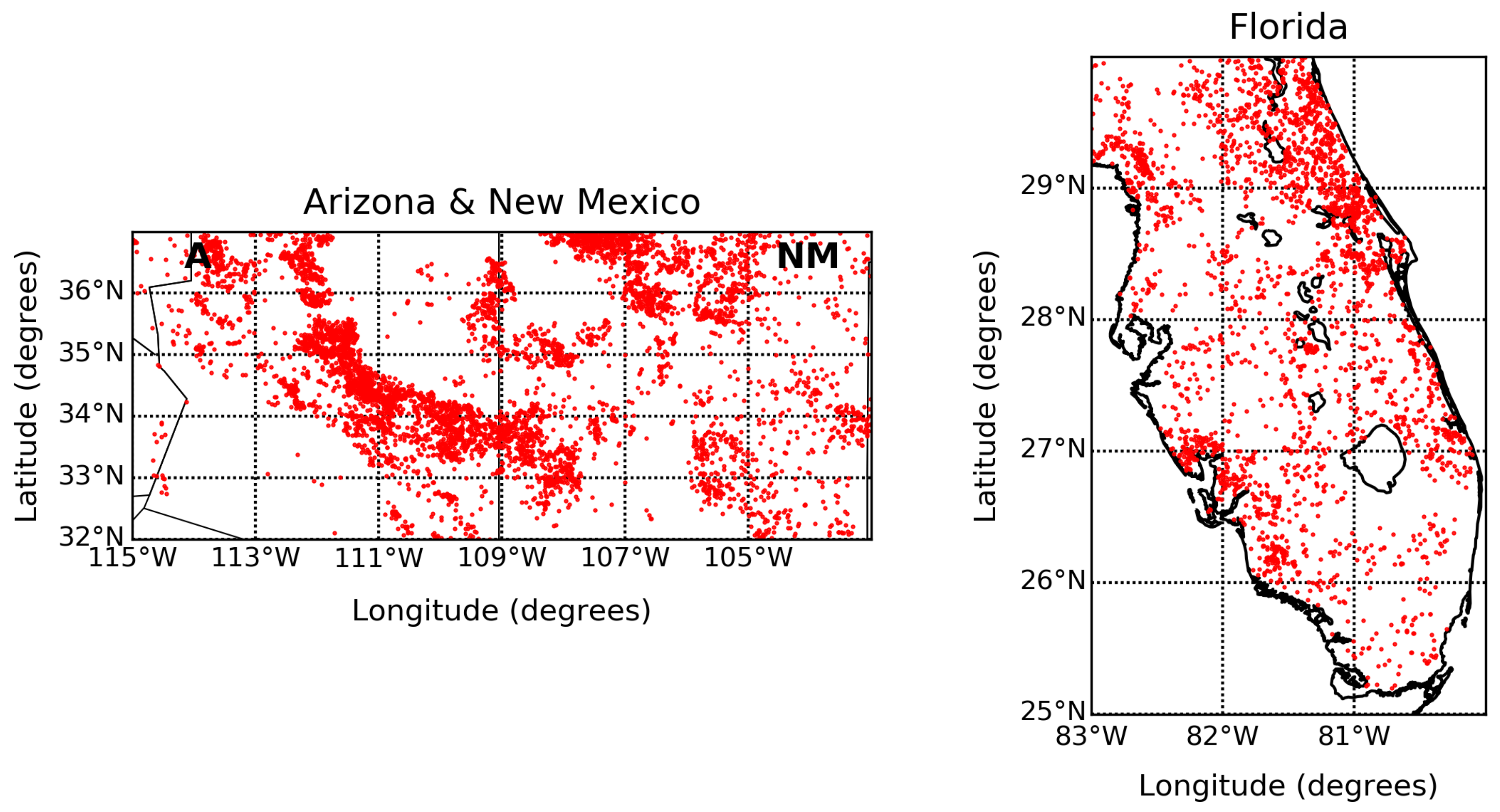

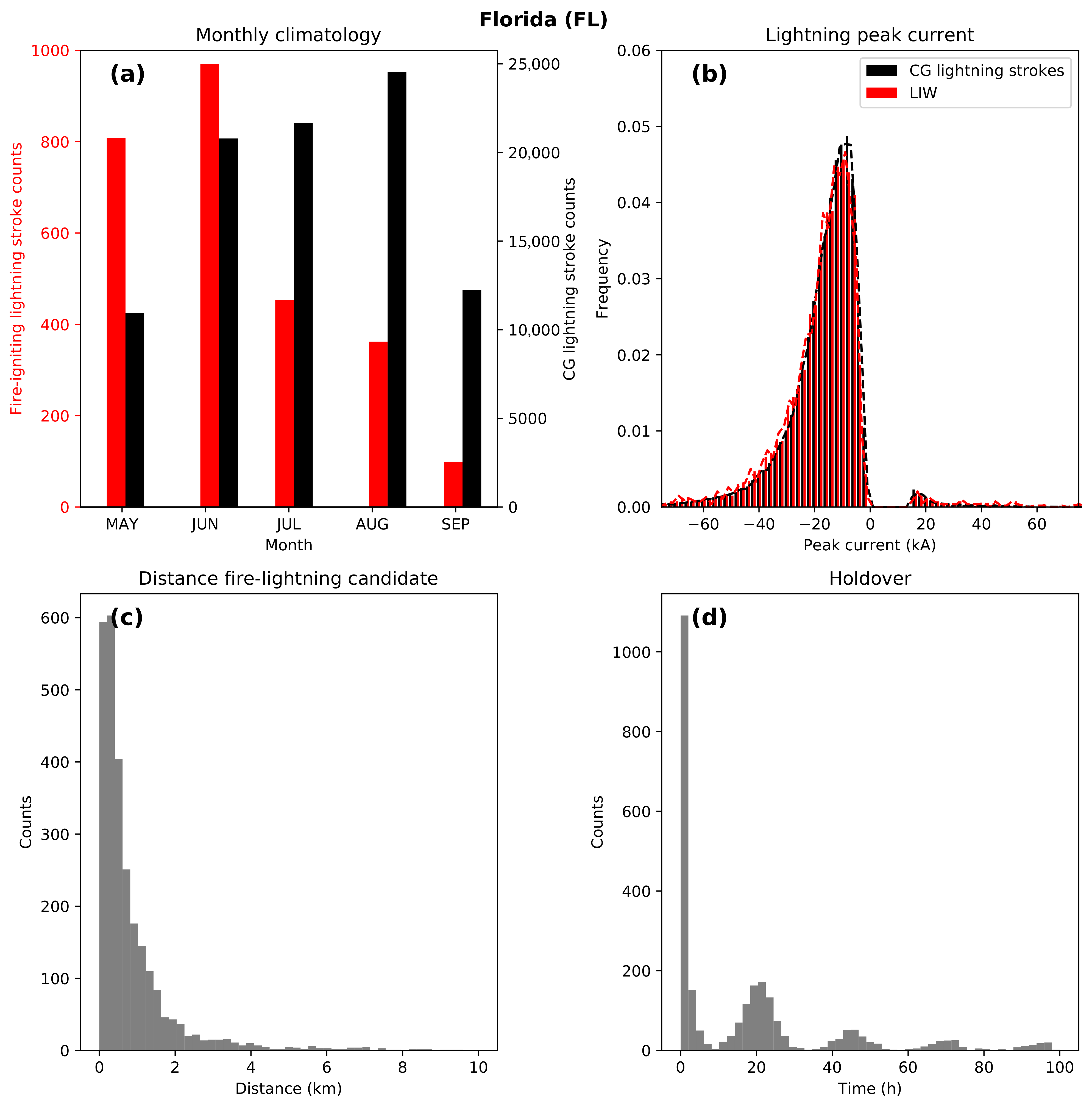

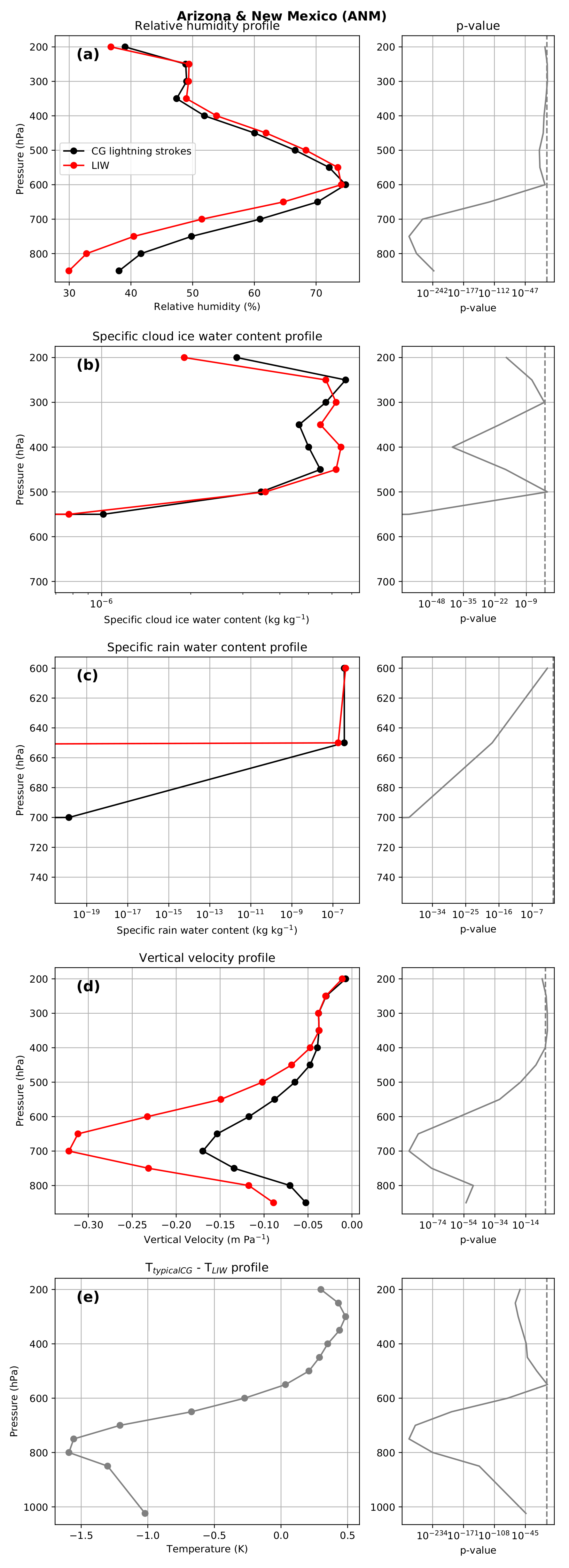
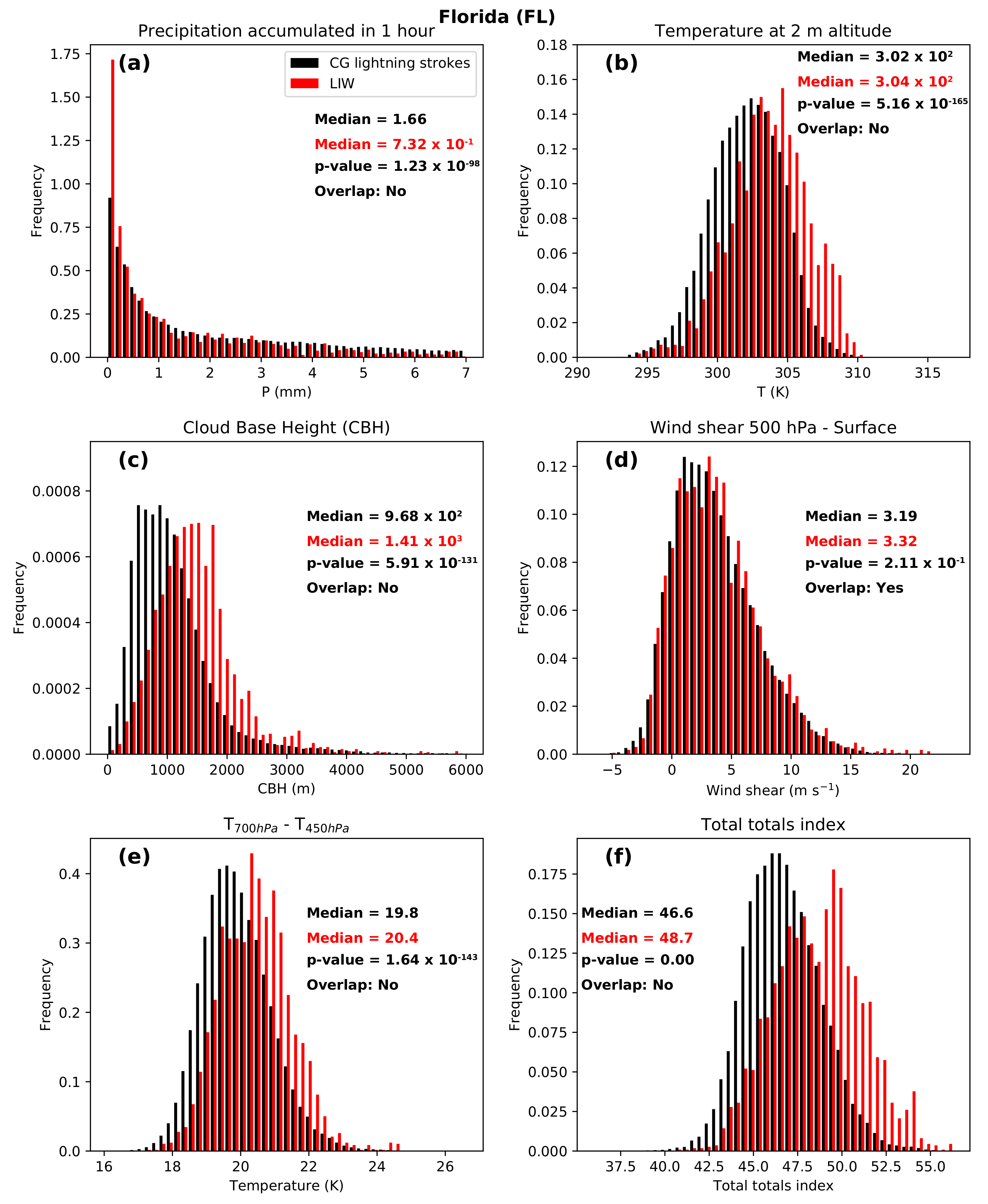
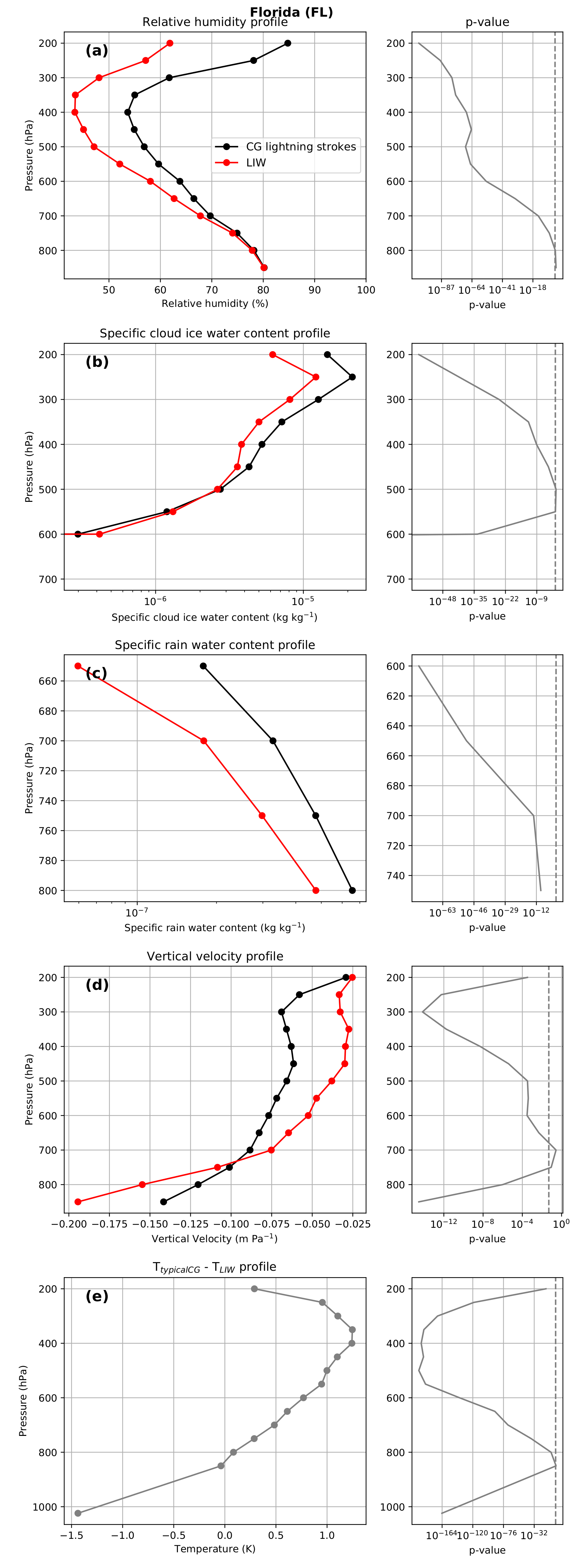

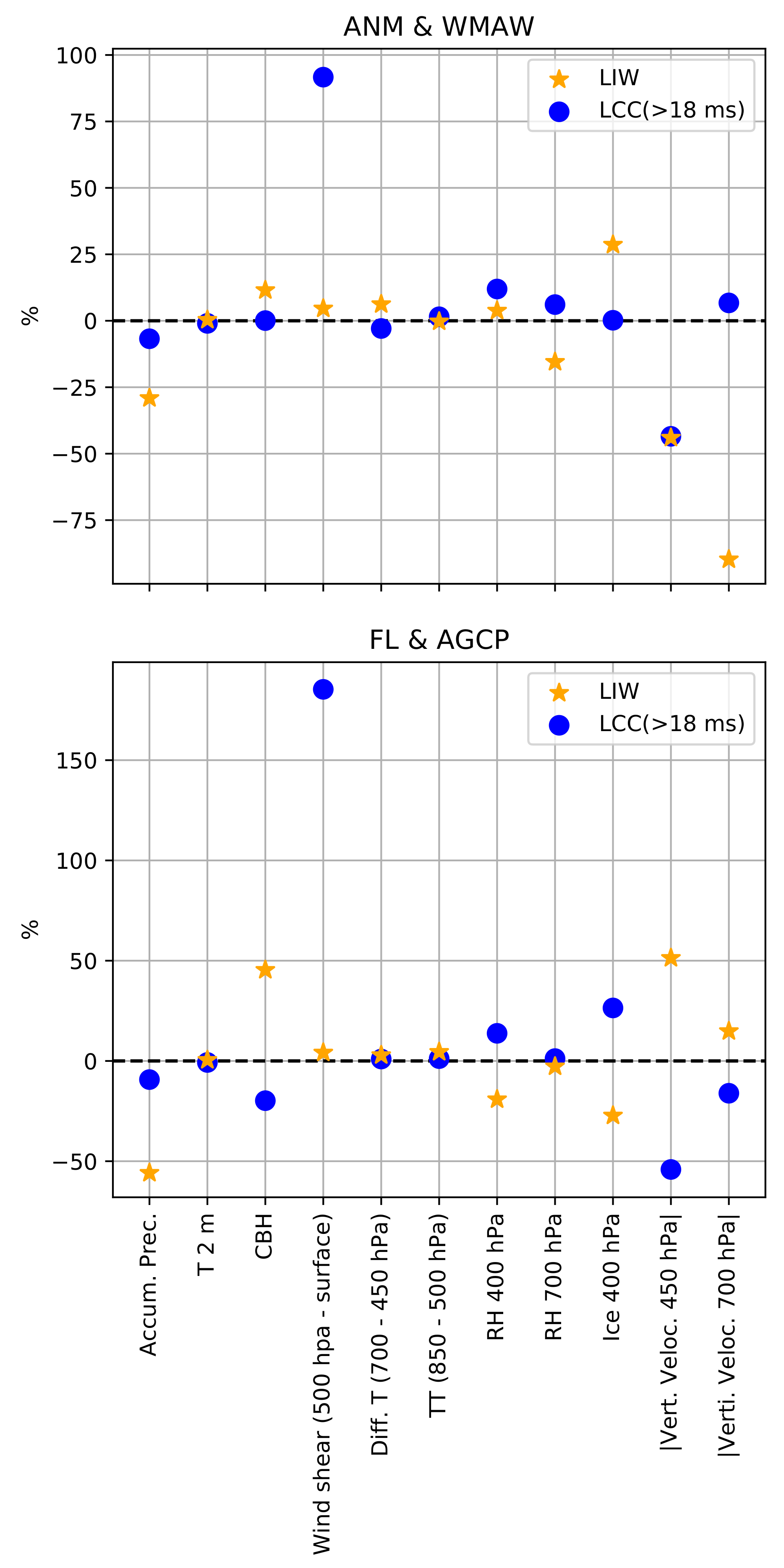
| Region | Forest Type | Area (km) | CG Strokes | LIW | LIE |
|---|---|---|---|---|---|
| Non forest | 465,167 (76%) | 9,356,452 (66%) | 1484 (24%) | 1/6305 (0.02%) | |
| Ponderosa pine | 30,130 (5%) | 1,159,701 (8%) | 2150 (34%) | 1/539 (0.19%) | |
| Arizona and New Mexico | Pinyon-juniper woodlands | 84,232 (14%) | 2,649,113 (19%) | 1860 (30%) | 1/1424 (0.07%) |
| Juniper woodland | 10,690 (2%) | 289,006 (2%) | 178 (3%) | 1/1624 (0.06%) | |
| Douglas-fir | 4373 (1%) | 157,241 (1%) | 173 (3%) | 1/909 (0.11%) | |
| Evergreen oak woodland | 4270 (1%) | 187,593 (3%) | 158 (3%) | 1/1187 (0.08%) | |
| Non forest | 130,319 (79%) | 9,096,387 (74%) | 1062 (39%) | 1/8565 (0.01%) | |
| Slash pine | 14,194 (9%) | 1,345,438 (11%) | 987 (37%) | 1/1363 (0.07%) | |
| Florida | Baldcypress-water tupelo | 8859 (5%) | 902,832 (7%) | 262 (10%) | 1/3446 (0.03%) |
| Sand pine | 1948 (1%) | 180,059 (1%) | 83 (3%) | 1/2169 (0.05%) | |
| Mixed upland hardwoods | 3024 (2%) | 275,862 (2%) | 63 (2%) | 1/4379 (0.02%) |
| Region | Arizona and New Mexico | Florida |
|---|---|---|
| Total number of LIW | 6301 | 2693 |
| Average index A | 0.87 | 0.86 |
| Median elevation of CG strokes | 1801 m | 10 m |
| Median elevation of LIW | 1912 m | 7 m |
| Median distance between fires and flash candidates | 0.4 km | 0.5 km |
| Median holdover | 12 h | 13 h |
| Average peak current of +CG in typical thunderstorms | 33.0 kA | 26.7 kA |
| Average peak current of +CG in LIW | 41.3 kA | 40.3 kA |
| Average peak current of −CG in typical thunderstorms | −18.6 kA | −19.8 kA |
| Average peak current of −CG in LIW | −20.6 kA | −19.2 kA |
Publisher’s Note: MDPI stays neutral with regard to jurisdictional claims in published maps and institutional affiliations. |
© 2022 by the authors. Licensee MDPI, Basel, Switzerland. This article is an open access article distributed under the terms and conditions of the Creative Commons Attribution (CC BY) license (https://creativecommons.org/licenses/by/4.0/).
Share and Cite
Pérez-Invernón, F.J.; Huntrieser, H.; Moris, J.V. Meteorological Conditions Associated with Lightning Ignited Fires and Long-Continuing-Current Lightning in Arizona, New Mexico and Florida. Fire 2022, 5, 96. https://doi.org/10.3390/fire5040096
Pérez-Invernón FJ, Huntrieser H, Moris JV. Meteorological Conditions Associated with Lightning Ignited Fires and Long-Continuing-Current Lightning in Arizona, New Mexico and Florida. Fire. 2022; 5(4):96. https://doi.org/10.3390/fire5040096
Chicago/Turabian StylePérez-Invernón, Francisco J., Heidi Huntrieser, and Jose V. Moris. 2022. "Meteorological Conditions Associated with Lightning Ignited Fires and Long-Continuing-Current Lightning in Arizona, New Mexico and Florida" Fire 5, no. 4: 96. https://doi.org/10.3390/fire5040096
APA StylePérez-Invernón, F. J., Huntrieser, H., & Moris, J. V. (2022). Meteorological Conditions Associated with Lightning Ignited Fires and Long-Continuing-Current Lightning in Arizona, New Mexico and Florida. Fire, 5(4), 96. https://doi.org/10.3390/fire5040096







